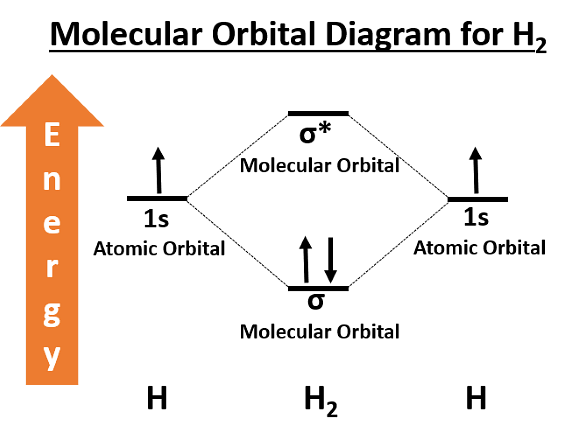The correct order of energies of molecular orbitals of N2 molecule, is
The correct order of energies of molecular orbitals of N2 molecule, is
σ1s<σ*1s<σ2s<σ*2s<σ2pz<(π2px =π2py)<(π*2px=π*2py)<σ*2pz
σ1s<σ*1s<σ2s<σ*2s<σ2pz<σ*2pz<(π2px=π2py)<(π*2px=π*2py)
σ1s<σ*1s<σ2s<σ*2s<(π2px=π2py)<(π*2px=π*2py)<σ2pz<σ*2pz
σ1s<σ*1s<σ2s<σ*2s<(π2px=π2py)<σ2pz<(π*2px=π*2py)<σ*2pz
The Correct Option is D
Approach Solution - 1
The molecular orbital (MO) energy ordering for diatomic molecules like N2 can be understood by considering the interaction between atomic orbitals. In diatomic molecules, energy levels are determined by the molecular orbital theory which involves the combination of atomic orbitals to form molecular orbitals. For molecules with less than or equal to 14 electrons, like N2, the order of energy levels is different from those with more than 14 electrons.
Steps to determine the correct order:
- Lower energy MOs: Start with the 1s orbitals. The molecular orbitals formed are σ1s and σ*1s, with σ1s being lower in energy than σ*1s.
- 2s orbitals: The next higher energy levels are formed by the 2s orbitals, resulting in σ2s and σ*2s, with σ2s being at a lower energy than σ*2s.
- 2p orbitals: When constructing MOs from p orbitals in second-period diatomic molecules:
- (π2px = π2py) has lower energy than σ2pz due to the node-related distribution in π orbitals offering slightly lower energy orientation.
- σ2pz has higher energy than (π2px = π2py), but less than anti-bonding π orbitals (π*2px = π*2py).
- (π*2px = π*2py) are filled after σ2pz and are higher in energy.
- Finally, σ*2pz is the highest energy orbital in these configurations.
Combining these observations, the correct order of molecular orbitals for N2 is:
σ1s < σ*1s < σ2s < σ*2s < (π2px = π2py) < σ2pz < (π*2px = π*2py) < σ*2pz
Approach Solution -2
- The molecular orbitals are arranged in increasing energy levels.
- The σ1s orbital is the lowest in energy as it is the bonding molecular orbital formed by the overlap of two 1s atomic orbitals.
- The σ*1s orbital is the next in energy, representing the antibonding orbital formed by the out-of-phase overlap of two 1s atomic orbitals.
- The σ2s orbital is lower in energy than the σ*2s orbital, as the σ2s is formed by the overlap of two 2s atomic orbitals.
- The (π2px = π2py) orbitals are degenerate and have the same energy level. These are the bonding and antibonding π molecular orbitals formed by the overlap of two 2px and 2py atomic orbitals.
- The σ2pz orbital is lower in energy than the (π2px = π2py) orbitals, as the σ2pz is formed by the overlap of two 2pz atomic orbitals.
- Finally, the (π2px = π2py) orbitals are the highest in energy among these molecular orbitals.
Therefore, The correct option is (D): σ1s<σ*1s<σ2s<σ*2s<(π2px=π2py)<σ2pz<(π*2px=π*2py)<σ*2pz
Top Questions on Chemical bonding and molecular structure
- A group 15 element forms \( d\pi - d\pi \) bond with transition metals. It also forms a hydride, which is the strongest base among the hydrides of other group members that form \( d\pi - d\pi \) bonds. The atomic number of the element is ________________________.
- JEE Main - 2025
- Chemistry
- Chemical bonding and molecular structure
Identify the correct orders against the property mentioned:
A. H$_2$O $>$ NH$_3$ $>$ CHCl$_3$ - dipole moment
B. XeF$_4$ $>$ XeO$_3$ $>$ XeF$_2$ - number of lone pairs on central atom
C. O–H $>$ C–H $>$ N–O - bond length
D. N$_2$>O$_2$>H$_2$ - bond enthalpy
Choose the correct answer from the options given below:- NEET (UG) - 2025
- Chemistry
- Chemical bonding and molecular structure
- Identify the geometry and hybridization of the central atom in SF₄.
- BITSAT - 2025
- Chemistry
- Chemical bonding and molecular structure
- What is the bond order for diatomic carbon according to molecular orbital theory?
- AIIMS Paramedical - 2025
- Chemistry
- Chemical bonding and molecular structure
- Which of the following has $\text{sp}^3\text{d}^2$ hybridisation?
- JEE Main - 2025
- Chemistry
- Chemical bonding and molecular structure
Questions Asked in NEET exam
A sphere of radius R is cut from a larger solid sphere of radius 2R as shown in the figure. The ratio of the moment of inertia of the smaller sphere to that of the rest part of the sphere about the Y-axis is :

- NEET (UG) - 2025
- Moment Of Inertia
A constant voltage of 50 V is maintained between the points A and B of the circuit shown in the figure. The current through the branch CD of the circuit is :

- NEET (UG) - 2025
- Current electricity
The current passing through the battery in the given circuit, is:

- NEET (UG) - 2025
- Current electricity
- Two gases A and B are filled at the same pressure in separate cylinders with movable pistons of radii \(r_A\) and \(r_B\) respectively. On supplying an equal amount of heat to both the cylinders, their pressures remain constant and their pistons are displaced by 16 cm and 9 cm respectively. If the change in their internal energies is the same, then the ratio \(r_A / r_B\) is:
- NEET (UG) - 2025
- Thermodynamics
- Which of the following enzyme(s) are NOT essential for gene cloning?
A. Restriction enzymes
B. DNA ligase
C. DNA mutase
D. DNA recombinase
E. DNA polymerase- NEET (UG) - 2025
- Molecular Biology
Concepts Used:
Molecular Orbital Theory
The Molecular Orbital Theory is a more sophisticated model of chemical bonding where new molecular orbitals are generated using a mathematical process called Linear Combination of Atomic Orbitals (LCAO).
Molecular Orbital theory is a chemical bonding theory that states that individual atoms combine together to form molecular orbitals. Due to this arrangement in MOT Theory, electrons associated with different nuclei can be found in different atomic orbitals. In molecular orbital theory, the electrons present in a molecule are not assigned to individual chemical bonds between the atoms. Rather, they are treated as moving under the influence of the atomic nuclei in the entire molecule.
